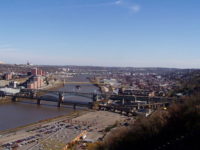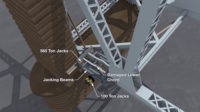Despite a fire on Pittsburgh’s Liberty Bridge last month, contractor Joseph B. Fay Co. missed by only four days a milestone to open the bridge’s fourth lane to traffic. After the Sept. 2 fire melted 30 ft of the lower-chord truss that carried substantial loads, Fay and the Pennsylvania Dept. of Transportation worked around the clock for 24 days to repair and realign the bridge temporarily. But even before the incident, the Oct. 19 milestone loomed: Crews had to open the bridge’s fourth lane to preconstruction traffic conditions.
The fourth lane was fully reopened on Sunday night, Oct. 23, after a weekend closure allowed crews to remove barriers, conduct line eradication and installation, and shift the overhead lane control system.
The team recovered several lost days by working weekends and double shifts on the $80.08-million contracted rehabilitation, which includes deck replacement, ramp reconstruction, structural steel repairs and concrete repairs. “We lost 24 days, basically,” says H. Daniel Cessna, district executive for PennDOT Engineering District 11-0. “So, they really made up a lot of time.”
But 22 of those days weren’t a total wash. PennDOT allowed Fay to resume work on areas unaffected by the fire two days into the closure, which each day diverted 55,000 vehicles from the bridge.
The lane closings triggered $3 million in liquidated damages, but Cessna says Fay likely would “negotiate that amount downward.” In a statement, Fay said the company hopes to “reach a final figure that’s in alignment with the conditions of the contract” and that considers “the hard work” needed to put the project back on schedule.
The fire and bridge repairs may have other financial repercussions. Cessna said PennDOT will attempt to recover “hundreds of thousands of dollars” of the department’s costs from Fay associated with the fire, including engineering consultant fees for repair design and planning.
It is unclear how much the contractor can recover under its insurance policies. “We are in private discussions with our insurers to resolve any claims,” Fay says.
The fire started when a welder accidentally ignited tarps and plastic pipe. By jacking and localized heating, Fay straightened the charred chord and redistributed the load on the bridge. The team cut the damaged member and jacked the bridge an inch and a half back into place. A temporary 9-ton weight limit was placed on the bridge while crews added steel to strengthen the truss chord. That limit was removed on Sept. 29, when the bridge’s preclosure weight limit— 30 tons—was restored.
PennDOT probably will enforce a 40-ton weight limit for the completely rehabilitated bridge. Permanent repairs still await approval.





Post a comment to this article
Report Abusive Comment